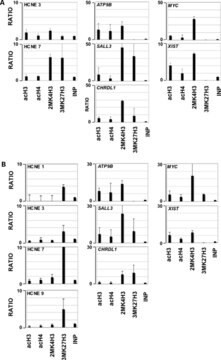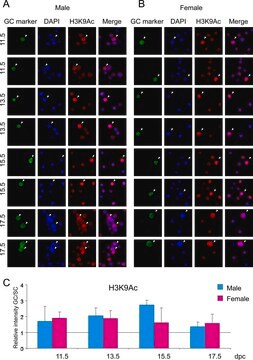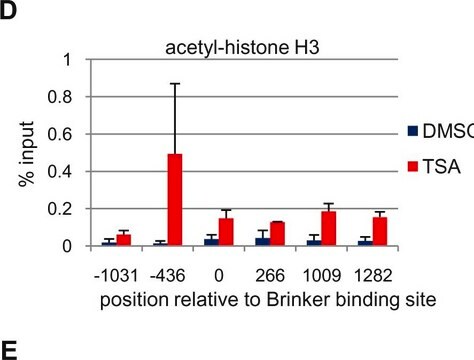07-329
Anti-acetyl-Histone H4 (Lys16) Antibody
Upstate®, from rabbit
Synonim(y):
Histone H4 Acetylated on Lysine 16, H4K16Ac, Histone H4 (acetyl K16), H4 histone family, member A, H4a
About This Item
Polecane produkty
pochodzenie biologiczne
rabbit
Poziom jakości
forma przeciwciała
affinity isolated antibody
rodzaj przeciwciała
primary antibodies
klon
polyclonal
oczyszczone przez
affinity chromatography
reaktywność gatunkowa
mouse, rat, human
producent / nazwa handlowa
Upstate®
metody
ChIP: suitable (ChIP-seq)
dot blot: suitable
inhibition assay: suitable (peptide)
multiplexing: suitable
western blot: suitable
izotyp
IgG
numer dostępu NCBI
numer dostępu UniProt
Warunki transportu
wet ice
docelowa modyfikacja potranslacyjna
acetylation (Lys16)
informacje o genach
human ... H4C1(8359)
mouse ... H4C1(326619)
Opis ogólny
Specyficzność
Immunogen
Zastosowanie
Immunocytochemistry Analysis: A 1:100 dilution from a representative lot detected Acetyl-Histone H4 (Lys16) in HeLa, A431, HUVEC, and NIH/3T3 cell lines.
Dot Blot Analysis: A 1:1,000 dilution from a representative lot detected Acetyl-Histone H4 (Lys16) in
an Absurance Histone H3 Antibody Specificity Array (Cat. No. 16-667) and an Absurance Histone H2A, H2B, H4 Antibody Specificity Array (Cat. No. 16-665).
Epigenetics & Nuclear Function
Histones
Jakość
Western Blotting Analysis: A 1:1,000 dilution of this antibody detected Acetyl-Histone H4 (Lys16) in lysates from Sodium Butyrate treated HeLa cells.
Opis wartości docelowych
Postać fizyczna
Przechowywanie i stabilność
For maximum recovery of product, centrifuge the vial prior to removing the cap.
Inne uwagi
Informacje prawne
Oświadczenie o zrzeczeniu się odpowiedzialności
Nie możesz znaleźć właściwego produktu?
Wypróbuj nasz Narzędzie selektora produktów.
Kod klasy składowania
12 - Non Combustible Liquids
Klasa zagrożenia wodnego (WGK)
WGK 1
Temperatura zapłonu (°F)
Not applicable
Temperatura zapłonu (°C)
Not applicable
Certyfikaty analizy (CoA)
Poszukaj Certyfikaty analizy (CoA), wpisując numer partii/serii produktów. Numery serii i partii można znaleźć na etykiecie produktu po słowach „seria” lub „partia”.
Masz już ten produkt?
Dokumenty związane z niedawno zakupionymi produktami zostały zamieszczone w Bibliotece dokumentów.
Nasz zespół naukowców ma doświadczenie we wszystkich obszarach badań, w tym w naukach przyrodniczych, materiałoznawstwie, syntezie chemicznej, chromatografii, analityce i wielu innych dziedzinach.
Skontaktuj się z zespołem ds. pomocy technicznej








